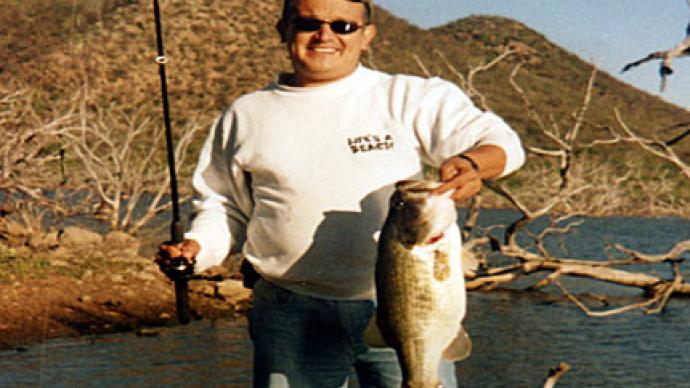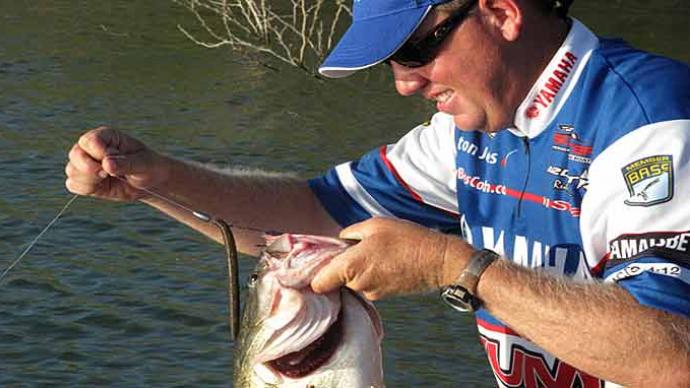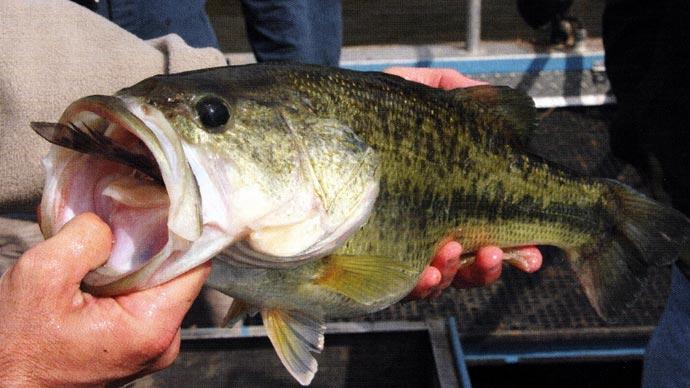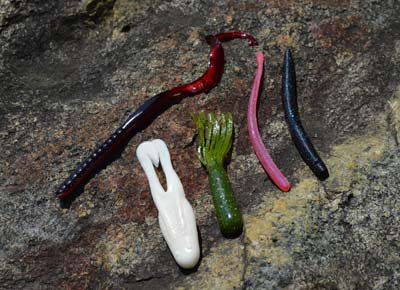
Decisions, decisions, decisions — bass fishing is filled with them. They start with when and where to fish. But the biggest for beginning anglers may be what bait to use, especially when it’s time to sling soft-plastic lures. Count sizes, colors, and styles, and the choices seem endless.
Lifelike in shape, size, and texture, and often filled with attractant, such as salt or scent, soft-plastic lures catch more than their fair share, especially in summer, when warm water supercharges bass’ cold-blooded metabolism. Knowing which to select, where to cast, and how to create the best presentations are essential steps on the road to becoming a better bass angler.
Streamlining your soft-plastic lure selection lets you focus on something more important — finding bass. No lure works unless that happens. So, narrow your choices to these five soft-plastic baits, which will keep you catching bass across a variety of situations all summer long.
-
Ribbon-Tail Worm
Image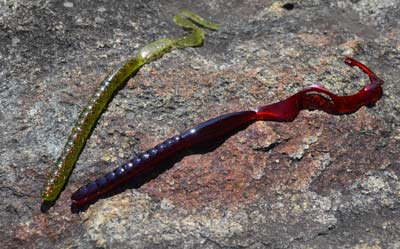
Ribbon tail worms are made for summertime fishing. Their action elicits plenty of strikes, and their slender profile attracts big bass. Photo by Pete M. Anderson If you had to pick one soft-plastic lure for summertime fishing, the ribbon-tail worm would be it. Sporting a slender profile and slithery tail, it has caught untold numbers of bass in many places. But you only need to rig it one way: Texas style. The sliding weight in front and hook tucked neatly inside set its tail free to create the most action without worrying about snags.
Don’t skimp on size. A 7½- or 8-inch ribbon-tail worm is the go-to. And keep handy a bag or two of snake-like 10-inches. They’ve convinced plenty of deep-water giants to bite, whether they swim in an offshore brush pile down south or along the edge of submerged aquatic vegetation up north.
How to rig it:
- Rod: Choose a fast-action rod with a heavy power for hooksets that will help with casting and presentation. It should measure 7 feet, a perfect length for fishing any soft-plastic lure.
- Reel: One that pulls in plenty of line with each crank — at least a 7:1 gear ratio — will keep you ready to set the hook.
- Line: Braided or fluorocarbon line from 14- to 30-pound test, choosing heavier as cover thickens, improves sensitivity and hooksets.
- Hook: Straight- or offset-shank hooks that feature a round bend provide plenty of gap — the vertical distance between line tie and hook point — ensuring solid hooksets, even if your worm slides down.
- Weight: Use just enough to set your worm’s tail swimming and get it to the bottom. That can be as little as 1/8 ounce but rarely more than 1/2 ounce. And don't peg it. A free-sliding weight gets more bites.
Move your ribbon-tail worm with your rod’s tip, lifting it 2 to 3 feet each time. While that’s more than most presentations, it creates more distance for your worm to sink on a semi-slack line, giving its tail time to draw strikes.
Ribbon-tail worms are better suited to casting than flipping. The long tail easily wraps around cover, such as dock posts, laydown branches, and emergent vegetation, preventing your worm from reaching the water. A straight-tail worm, for example, will ruin fewer presentations.
Throw it in these spots:
- Sunken brush piles: Every one of these is a summertime hotspot, but those near structure, such as a point, ledge, or creek channel, are always better.
- Submerged aquatic vegetation: Aim your casts at points and pockets along the edges of a bed and holes within it. The last gives away spots of hard bottom, such as sand or rock, which congregate bass.
- Seawalls or riprap: Bass cruise these shallow-water spots searching for bluegill, which spawn on each full moon in summer. A giant ribbon-tail worm is an excellent imitator of these meals.
-
Finesse Worm
Summertime bass occasionally turn their noses up at large lures; some situations require small baits. So, pack finesse worms, too. Most have a straight tail, thin diameter, and measure 4 inches to 5 inches long. Water color is a good rule of thumb for selecting a color of these or any soft-plastic lure. Use natural colors, such as watermelon or smoke, in clear water and darker colors, such as green pumpkin or black, in stained to muddy water. Bright colors, such as morning dawn, are favorites of smallmouth and spots, even in clear water.
Finesse worms can be rigged many ways. A simple Texas or Neko rig is dynamite around shallow cover. Thread one onto a shaky head to target deep-water largemouth and spotted bass. Add one to a drop shot, and you’re ready for summertime smallmouth.
How to rig it:
- Rod: A fast-action spinning rod with medium power will handle any finesse-worm duty.
- Reel: Find one with plenty of ball bearings for smooth operation, a large-diameter spool to eliminate wind knots, and a front drag that slips at just the right time while battling a big bass.
- Line: Thread-thin 6- to 10-pound test braided or fluorocarbon line will allow your finesse worm more action and transmit the lightest bites, all while lacking the stretch that can fumble hooksets.
- Hook: Choose a 1/0 or 2/0 straight- or offset-shank hook with a round bend. Avoid extra-wide gap hooks, whose point and line tie are in the same plane.
- Weight: Weight varies with presentation. It can be as light as 1/16 ounce when Texas rigging or ½ ounce for drop shotting.
For a look that most bass haven’t seen lately, if at all, Texas rig your finesse worm on a lightweight weedless head such as those made by Slider. Slowly swim it over and through sunken brush or submerged vegetation. Don’t dismiss it as a small fish tactic; it catches big ones, too.
Throw it in these spots:
- Docks: If the bass in your lake have seen too many jigs and creature baits, they’ll usually slurp up a finesse worm without hesitation.
- Submerged aquatic vegetation: Rigged on a lightweight weedless head, make long casts and slowly swim your finesse worm through the plants’ tops.
- Deep water: Pick apart the structure and submerged cover with a finesse worm on a shaky or darter head. Rig up a drop shot for bass slightly suspended off the bottom or in current.
-
Stick Worm
Led by Yamamoto’s Senko, this simplistic worm, which sports a pointed tail and makes a slight shimmy, is a bass-catching machine year-round. So, never leave the dock without a couple of bags of them.
While manufacturers offer various diameters and lengths, a 5- to 6-inch stick worm will be your best friend all summer. It's perfect for all bass sizes, entertaining you with plenty of bites while providing a legitimate shot at a personal best. You only need to rig it one of two ways, and neither requires a weight. Wacky, with the hook impaled once perpendicularly through the worm's center, allowing the head and tail to wiggle, is best when the cover is thin. Rig yours Texas-style when the cover is thick.
How to rig it:
- Rod: Choose a spinning or casting rod, but its action must be fast and power at least medium heavy.
- Reel: Find one with a medium retrieve speed sized to handle the appropriate pound test of line.
- Line: Spool up with 15- to 50-pound test braid or 8- to 15-pound test fluorocarbon, depending on cover thickness. Both will help you feel the light bites that weightless soft plastics draw.
- Hook: Stick with a straight- or offset-shank hook with a round bend, whether rigging wacky or Texas style.
Stick worms derive most of their enticing action from the tender plastic used to pour them. That makes durability a common liability, though the number of bass they catch makes it relatively easy to handle.
You can add life to your stick worms in a couple of ways. If you're rigging it wacky, use an o-ring to secure the hook, reducing tears. And save those that are worn out from Texas rigging. Cut off the last 3-inches of the tapered tail end, and you'll have a Ned rig bait.
Throw it in these spots:
- Docks: Weightless stick worms are perfect for fishing these classic shallow water hot spots. Work from the outside in, being sure to skip your lure into hard-to-reach spots.
- Submerged aquatic vegetation: Let your stick worm shimmy down along edges or into holes. The less you move it, the better.
- Shallow flats: Target smallmouth by wacky rigging your stick worm and targeting isolated cover such as pieces of sunken wood, large rocks, or even boat-mooring weights.
-
Image
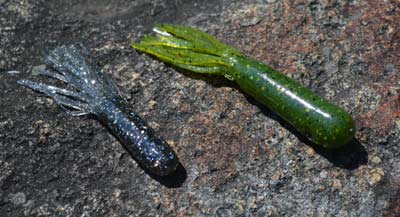
A 31/2- or 4-inch tube will catch bass all summer, from shallow rocks and vegetation to open-water flats. It can be Texas rigged and flipped into heavy cover, too. Photo by Pete M. Anderson Tube
These streamlined baits resemble various bass foods, including baitfish, crawfish, and gobies. They're finesse in stature, so bass are always ready to eat one. They can be fished in various situations and with different retrieves, allowing you to add as little or as much action as bass want.
Tubes are poured in several sizes, but the 3 ½- to 4-inch models will cover all your summer needs. Choose ones with finely cut tails, which produce extra action. They work best in clear or slightly stained water.
How to rig it:
- Rod: Fish your tubes on a fast-action spinning rod that sports a medium power.
- Reel: Choose a reel with plenty of ball bearings, a large-diameter spool, and a large front drag.
- Line: Spool up with 6- to 10-pound test fluorocarbon or low-stretch monofilament line.
- Hook: Insert a jig head built with a high-quality hook. Flat ones make your tube glide, and bulbous ones give it a goby profile, an important detail on any Great Lakes waterway.
- Weight: Match it to depth and current. Heads weighing 1/16, 1/8, and ¼ will cover nearly every summertime situation.
While you only need a spinning rod to fish tubes in summer, you may want to try this variation with a casting rod and strong line, at least 20-pound test fluorocarbon or monofilament. Texas-rigged tubes can be flipped into the heaviest submerged or emergent aquatic vegetation. Their shape helps them slide through to the bottom. Be sure to peg your weight — at least 3/8-ounce — and run the hook bend through the tail before putting the point in the plastic. That improves hook sets.
Throw it in these spots:
- Open-water flats: Find smallmouth with a jigging retrieve, or simply dragging your tube across the bottom as you drift.
- Moving water: Search out eddies and current seams, where bass wait for meals to drift by. Throw your tube into moving water, and work it toward slack water.
- Shallow rocks and grass: This classic North Country combo offers prime summertime fishing. Let your tube rest on the bottom between twitches, allowing its tails to dance seductively.
-
Image
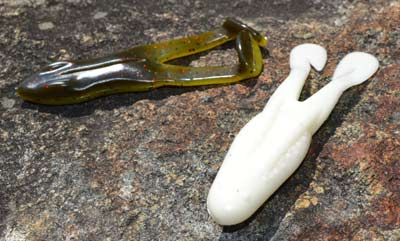
Rig soft-plastic toads weedless for thick cover, or try them on a buzzbait when bass are chasing shad in more open water. Photo by Pete M. Anderson Toad
Toads are built for extracting largemouth from thick aquatic vegetation. But they work well in other places once you look past their unitasker exterior. See them as a finesse version of a buzzbait, and you’ll spy plenty of places to throw them.
Toads have one of two types of kickers. Some, such as Zoom’s Horny Toad, have twisty ones, which kick best in thick cover. The others, such as Stanley’s Ribbit, have paddles, which work better in sparse cover or open water. Color is mostly a personal preference. Many anglers like how the added visibility of white leads to more hooked bass. If you can’t see your toad after a splashy strike, it’s safe to assume it’s in the bass’s mouth.
How to rig it:
- Rod: A fast-action casting rod with a heavy power will improve casting distance and accuracy and have the power to pull big bass from heavy cover.
- Reel: A medium-retrieve gear ratio between 6:1 and 7:1 makes moving your toad at the perfect speed comfortable.
- Line: Use 30- to 50-pound braided line, whose lack of stretch means better hook sets at long distances. Its durability cuts through vegetation instead of wrapping around it, and its sensitivity helps you feel when a bass has your bait.
- Hook: The extra gap provided by a 3/0 or 4/0 round-bend straight-shank hook ensures solid hooksets even if your toad wads up in it. Choose a flipping version if you want extra strength.
- Weight: Only use some when you want your toad to ride lower, helping bass bite it. Peg a 1/16-ounce tungsten bullet weight in front. Its small size is less likely to pick up debris.
More and more bass anglers are sometimes stepping away from Texas rigging their toads, instead replacing a buzzbait’s skirt with a twisty-footed toad or adding one to a specially designed buzzer frame. The big profile and flailing action work best when bass are chasing baitfish around sparse cover.
Throw it in these spots:
- Matted vegetation: This traditional toad target includes lily pads, topped-out milfoil, and cut grass collected on the surface. Key on edges, including where different plants mingle, holes, and other pieces of cover, such as a laydown, within a bed.
- Docks: Texas-rigged toads skip with relative ease. So, send yours into the deepest darkest corners of a dock and hold on tight. Don’t despair if you’re toad doesn’t immediately pop to the surface; bass will engulf a swimming one.
- Riprap bank: These shoreline stretches always produce a few bass and are perfect for a buzzbait-and-toad combination, especially during early summer’s shad spawn. Keep your lure in the strike zone longer by aiming your casts along the rock.


